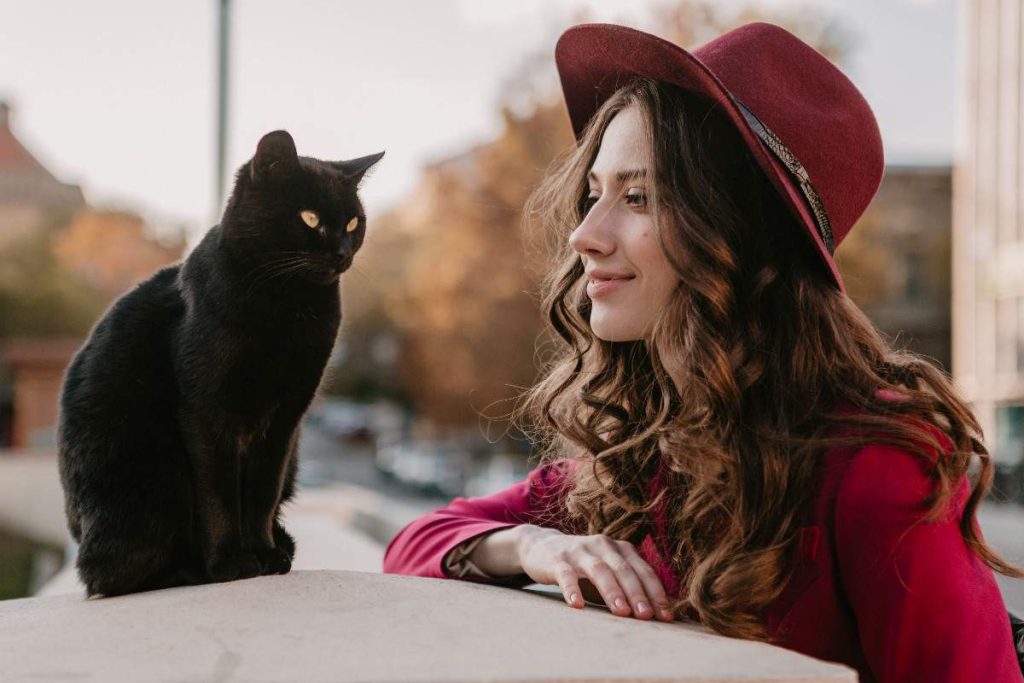The first time I saw a Bombay cat, I was struck by its stunning glossy black fur and golden eyes that seemed to glow. Often called a mini panther, this rare breed is truly unforgettable. With a muscular frame and sleek posture, it might look a bit intimidating at first, but don’t be fooled—this feline is one of the most relaxed, friendly, and sociable companions you’ll ever meet. Their quiet presence and love for cuddling make them the ideal loyal companion for those who enjoy calm, affectionate pets.
What makes the Bombay extra special is its origin. Developed in the 1950s by crossing a sable Burmese with a black American Shorthair, the breed was designed to resemble a miniature black panther. Everything about this cat echoes that vision—from the sleek black coat, copper eyes, and graceful sway in its walk, to the dark paw pads and whiskers. These small, robust cats usually weigh between 7–12 pounds and stand around 9–13 inches tall. As a hybrid cat, the Bombay thrives in a family setting where it receives lots of attention. It loves to walk on a leash and hates being left alone, making it perfect for people who can give it time and love in their home.
Why Choose a Bombay Cat?
If you want a cat that looks like a mini panther but acts like a cuddly best friend, the Bombay cat is your match. It’s a loyal companion with a sleek black coat, golden eyes, and a heart full of affection. Smart, sociable, and easy to live with, the Bombay fits right into any loving home—especially one that values both beauty and bonding.
Breed History
Back in 1953, a passionate cat breeder named Nikki Horner from Louisville, Kentucky, had a bold vision. She wanted to create a miniature panther—a jet-black cat with copper eyes, a muscular build, and a lithe body that moved with grace. Inspired by the black leopards of India and the mysterious energy of the city of Mumbai, she began her journey by breeding a black American Shorthair male known for its strong eye colour with a sable Burmese female. This mix of founding breeds—the Burmese and American Shorthair—was the starting point of what would become the Bombay breed.
Over the next few years, through selective breeding, outcrossing, and strict control of the breeding line, Horner refined her creation. The result was a midnight-black, striking black cat with a body that was slightly longer, less compact, but clearly muscular—carrying the best traits of its ancestry. The Bombay was both curious and sociable, thanks to the Burmese, and had the laid-back personality of the American Shorthair.
By 1966, the Bombay had emerged as a separate breed. It gained CFA registration in 1970, followed by championship status in 1976 under the Cat Fanciers Association. The International Cat Association followed suit in 1979, and by 1982, the first Bombay achieved a national win. With the nickname parlour panther or parlor panther, this breed has truly earned its place in the hearts of cat lovers across the U.S. and beyond.
Personality, Appearance & Build of the Bombay
Personality and Social Traits
Unlike many cats that enjoy their independence, Bombay cats thrive on human companionship and deep affection. They’re often called “Velcro cats” for their strong attachment to their owners. If you spend long hours at work or travel frequently, a Bombay might not suit your lifestyle—they need consistent attention and can become depressed if left alone. These cats are incredibly outgoing and sociable. They love to greet strangers with curiosity, and they’re fantastic with gentle children, friendly dogs, and other cats, especially if they’re raised together.
Coat and Unique Appearance
When it comes to looks, the Bombay is sleek and unforgettable. Its friendly and alert expression is matched by its glossy black coat, which is jet black, smooth, and shimmering. This satin-like short coat lies close to its muscular body, highlighting their lean build. The CFA praises this unmistakable look, describing the coat as “black to the roots.” A Bombay cat must have no white or mixed coat color—even the nose and paw pads are black.
Body Shape and Size
Bombays are medium-sized cats, well-balanced, and solidly muscular. Their straight tail is of medium length, and their overall build shouldn’t appear compact. Most Bombays weigh 8–15 pounds, with female cats usually being smaller. The mini panther vibe is emphasized by a round, medium-sized head with no sharp angles, a rounded muzzle, and circular eyes set wide apart. Their ears, too, are broad at the base and rounded at the top. Their eyes come in shades of gold to copper, and the CFA prefers them brighter, brilliant, with strong depth, giving that alert, curious look.
Legs and Paws
The Bombay’s strong body continues down to its legs and paws. Their legs are in proportion to the torso, head, and tail, and are medium-length and muscular. Their paws, round like a panther’s, have five toes in front and four in back—another subtle yet powerful trait of this majestic feline.
Temperament of Bombay Cat
The Bombay blends the laid-back nature of the American Shorthair with the curious and playful traits of the Burmese. This breed is known for being chatty, friendly, and deeply attached to human company. Whether they’re cuddling under the covers or playing games, Bombays thrive on affectionate attention. Their typical Bombay cat personality is best summed up as curious—always ready to roam the outside world, but equally content indoors, climbing your furniture or burrowing under blankets for a nap.
A Bombay cat is highly intelligent, often exploring the house when bored. You might catch this mini panther prowling countertops or digging in cabinets if you’re not being attentive. Keep them stimulated with a puzzle game or interactive toy. Despite their wildcat looks, Bombays are a calm cat that adapts well. They’re comfortable in prominent families, with children and dogs, or even in a small apartment. Some even take to a leash if trained as a Bombay cat kitten.
If you own a black Bombay cat, you’ve likely experienced how deeply affectionate this sociable animal can be. They love curling up on your lap or bed, seeking cozy time whenever they like. If you’re looking for a pet that keeps its distance, then the Bombay isn’t for you—these cats aren’t lazy or inactive. They’re explorers at heart, always in tune with your presence and eager to stay close.
Caring for a Bombay Cat
Grooming the Glossy Coat
The Bombay cat has a glossy coat that doesn’t need much maintenance. A simple brushing once a week is enough to manage shedding and keep the coat shiny and healthy.
Nutrition and Hydration
Feed your Bombay a healthy diet made of high-quality cat food, preferably protein-rich. Always provide access to clean water to maintain proper hydration and overall wellness.
Exercise and Mental Stimulation
Bombays are active and intelligent. They love playtime and benefit from interactive toys, puzzle toys, and even leash walking. These activities keep them physically fit and mentally engaged.
Emotional Needs and Companionship
This breed thrives on companionship and emotional connection. Meet their emotional needs with daily attention and affection, as they dislike being left alone for long.
Health and Hygiene
Routine vet checkups, vaccinations, and basic care like dental care, nail trimming, and ear cleaning are important. Keeping up with these will prevent health issues.
Indoor Safety and Comfort
As an indoor cat, the Bombay is sensitive to temperature changes. Ensure safety and a comfortable environment with plenty of indoor enrichment to keep them happy and healthy.
Conclusion
The Bombay cat is more than just a striking beauty with its glossy black coat and golden eyes—it’s a truly affectionate, intelligent, and loyal companion. Their mini panther looks and sociable, laid-back nature draw many people to Bombays, making them a wonderful addition to any loving home. With just a bit of regular grooming, quality food, and emotional attention, this breed thrives in both small apartments and active households. If you’re seeking a cat that blends elegance with playfulness, and independence with devotion, the Bombay cat might just be the perfect feline for you.
Frequently Asked Questions (FAQs)
Q1. Are Bombay cats friendly with children and other pets?
Yes! Bombay cats are naturally sociable and friendly. They usually get along well with gentle children, friendly dogs, and other cats, especially when raised together.
Q2. How much grooming does a Bombay cat need?
Their glossy black coat is low-maintenance. A light brushing once a week is enough to control shedding and maintain their shine.
Q3. Do Bombay cats like being alone?
Not really. They are known as “Velcro cats” because of their strong attachment to people. Long periods alone can make them feel depressed.
Q4. Are Bombay cats indoor or outdoor cats?
They are best suited as indoor cats. Their temperature sensitivity and affectionate nature mean they thrive in safe, controlled environments with lots of enrichment.
Q5. Do Bombay cats enjoy being walked on a leash?
Yes! Many Bombays can be trained for leash walking, especially if you start when they’re kittens. It adds mental stimulation and exercise.


